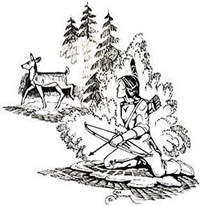
|
Hunting: The Secwepemc hunted and snared game throughout the fall. For meat, they depended on deer, moose, elk and caribou. Porcupine and squirrel were also eaten. Hunters used deer calls and prepared themselves for several days before a hunt. Sometimes the hunters waited at the animals favourite drinking places. Sometimes they waited at salt licks- places where the animals came to lick the salty ground. Secwepemc hunters could imitate animal and bird calls, as well as mimic the sound of bucks rutting by rubbing antlers against branches. |
 |
| Click to Learn more about Hunting |
Before the arrival of Non-natives the Secwepemc had access to everything they needed to survive.
Various winter settlements and summer camps were strategically placed to use the many resources of the land within Secwepemc traditional territories.
People of one area tended to use the resources located in their part of the territory. One hunting story told by elder Loretta Seymour tells of a man that would go hunting before the sun rose. Because he was taught to share his kill he would be certain to give his elder teacher a gift of the deer's kidneys.
Some men were known for their skills in hunting. They would often be called on to lead the hunt. This person or leader had certain powers and responsibilities similar to a chief. He had a duty to ensure that community members were properly fed. One of the unwritten laws is that it is all right to depend upon one another when in need.
It was said that the older women of the community who had no one to hunt for them would automatically go and collect their meat when a hunter came home from hunting. No questions were asked, and what was available was shared fairly with others in the village that needed deer meat.
Tools Used in the Hunt
Arrow shafts were fashioned from rosewood or saskatoon wood. The arrow was grooved along its length to allow blood to escape, which made it easier to track the wounded animal. The wood was smoothed with a stone, then painted with red ochre. Bird feathers were attached to the shaft to assist with accuracy. The feathers were painted red halfway down, a common Secwepemc arrow symbol.
A bag, called a quiver, was used to carry arrows. These were made from wolverine or fisher skins. Daggers were common hunting tools, most of which were made from bone or antler. Knives were fashioned from jade and fastened to handles carved from bone or wood with sinew or hemp string. Sometimes game calls were carried in the quiver, carved from bone or wood.
Secwepemc hunters used snowshoes, traps, snares, barriers, dug out pits, spring traps, corrals, and deer fences to aid in their hunting. Animals were skinned and cleaned on the spot they were killed. The meat taken was divided equally amongst the hunting party.
Click the graphic to learn more about hunting and the tools used.
|
|
